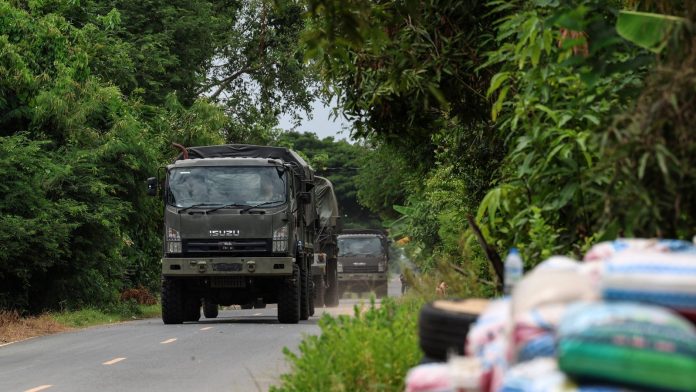Bridging Borders: Thailand and Cambodia’s Fragile Ceasefire and the Human Toll of Conflict
In the verdant borderlands where Thailand’s lush jungles slope gently down toward Cambodia’s ancient ruins, a fragile peace has been reclaimed after days of harrowing violence.
Five days of deadly skirmishes—marked by artillery fire, ground troop exchanges, and the echoes of history’s colonial-era scars—left at least 43 people dead and shattered the lives of hundreds of thousands. The catalyst? A centuries-old dispute over temple sites, relics of a complicated past that neither nation has fully reconciled.
And yet, amid the smoke and sorrow, diplomacy still finds a way. Thailand and Cambodia have just agreed to extend a ceasefire, a tenuous but crucial lifeline brokered by none other than Malaysian Prime Minister Anwar Ibrahim, chair of ASEAN, together with the unlikely but determined backing of the U.S. and Chinese governments. Their collective pressure led to three days of intensive talks in Kuala Lumpur, culminating in a joint statement lifting the curtain on a renewed commitment to peace—at least for now.
Ceasefire Amid Clashing Narratives
“Both sides agree to a ceasefire involving all types of weapons, including attacks on civilians and civilian objects and military objectives of either side, in all cases and all areas,” the statement declared solemnly.
That pledge, however, is a promise made fragile by the scars of mistrust. Early in the truce, accusations flared from both camps of ceasefire violations—sporadic skirmishes punctuated moments of uneasy quiet along the winding 800-kilometer (nearly 500-mile) border. But these confrontations quickly subsided, giving way to cautious optimism.
“We are here for a detailed ceasefire arrangement to stop bloodshed and the suffering by soldiers and civilians of both sides,” said Cambodian Defense Minister Tea Seiha during a joint press conference. His Thai counterpart, Deputy Defense Minister Nattaphon Narkphanit, echoed the sentiment, emphasizing “cooperation and sincerity” as the bedrock for lasting peace.
From the bustling markets of Aranyaprathet on the Thai side to the quiet villages of Oddar Meanchey in Cambodia’s border province, where aid agencies now rush to assist displaced families, the peace is felt most acutely in the bloodstained soil beneath ordinary feet.
Beyond the Surface: A Deeper Historical Wound
What sparks conflict in this region does more than ripple across maps—it reopens wounds etched deep in history. The border dispute hinges on ambiguous demarcations drawn during Cambodia’s time as a French protectorate in 1907, when colonial powers carved up territories with little regard for the people who called those lands home.
These temples aren’t just stone and mortar; they are cultural touchstones and symbols of national pride. “They’re a part of our identity,” a Cambodian villager, Channthy, confided quietly as she gathered her belongings at a refugee camp. “They remind us where we come from, but now they bring us pain.”
Such emotional stakes illustrate a larger, global truth: borders drawn without dialogue sow seeds of division that can bloom into cycles of conflict. And where sacred spaces and sovereignty intertwine, solutions grow ever more complex.
The Human Face of Displacement
Over 300,000 people were forced to flee their homes amid the clashes—families with children clutching ragged backpacks, elders navigating dusty roads in search of safety. The exodus carried its own silent tragedies: livelihoods uprooted, schools shuttered, health services stretched thin.
Aid organizations working in Cambodia’s Oddar Meanchey have described the unfolding crisis as “a race against time,” mobilizing resources to shelter and feed refugees while balancing fragile relations with host communities. According to UNHCR data, displacement numbers from this border conflict rival some of the worst in Southeast Asia in recent memory.
“People don’t want to fight,” said Somchai, a Thai fisherman watching the situation unfold near the border. “We just want to live peacefully, put food on our tables, and watch our children grow.”
Diplomacy’s Delicate Dance
Against this backdrop of human suffering, the diplomatic choreography in Kuala Lumpur unfolded with intense urgency and a shared understanding that the stakes are enormous. The talks resulted in several tangible agreements:
- Maintaining the current freeze on troop movements and patrols along the border
- Setting a date for another meeting within the next month
- Agreeing to refrain from spreading misinformation and inflammatory propaganda
These measures, while pragmatic, must be more than paper promises. “Disinformation can ignite fires as swiftly as guns,” noted Dr. Lina Vong, a Southeast Asia expert at the University of Singapore. “Controlling the narrative is essential to breaking the cycle of violence.”
What Lies Ahead?
As you read this, the future of this border region remains uncertain, balanced delicately between renewed hope and the shadows of unresolved grievances. How do nations lay down the heavy burdens of history and forge a path toward cooperation and coexistence?
This question resonates far beyond Thailand and Cambodia. In our own divided landscapes—from urban centers grappling with ethnic tensions to rural areas caught in claims over land and resources—there are echoes of this ceaseless challenge: Can empathy and dialogue transcend entrenched divides?
For now, the people along the Thailand-Cambodia border inch toward normalcy, guided by diplomats but fueled by their own resilience. This ceasefire, extended under guarded circumstances, is not a final destination but a waypoint—an invitation to imagine a world where shared heritage blooms into shared peace.
When borders clash with human lives, nations must ask themselves: What kind of legacy do we want to leave? And what steps can we take, today, to ensure that temples stand not as battlegrounds but as beacons of unity?





